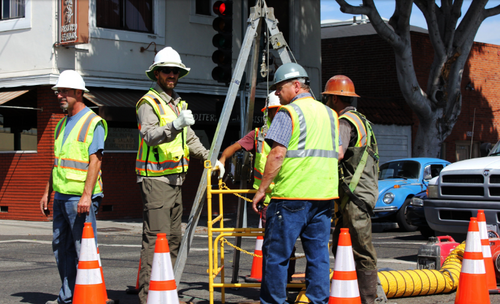When is Hi-Vis Required? Understanding High-Visibility Requirements
Most people have heard the expression: "dress for success”. Here at PK Safety, we like to dress to stay safe. It’s critical that workers can be seen when working in road construction sites and alongside traffic to prevent “struck-by” accidents. One of the most important forms of protection for workers is high-visibility apparel.
OSHA requires high-visibility clothing but doesn't call for it outright. Under the federal worker-safety "general duty clause" companies and business owners are required to provide: “employment and a place of employment which are free from recognized hazards that are likely to cause death or serious physical harm to his employees”. ANSI/ISEA 107-2010 sets performance criteria for high-visibility safety apparel in order to reduce hazards present to workers at risk for being struck.
The performance criteria specifies background, retroreflective, and combined-performance materials. Background material is “colored fluorescent material intended to be highly conspicuous, but not intended to comply with the requirements… for retroreflective material.” Retroreflective material “reflects and returns a relatively high proportion of light in a direction close to the direction from which it came.” And combined-performance material is “retroreflective material that is also a fluorescent material and can be counted toward the minimum area requirements for background material.” ANSI/ISEA 107-2010 requires that the three materials be certified by an accredited, independent third-party laboratory to ensure that the materials meet the specified performance criteria imposed by the standard. Certain amounts of reflective material are required to meet hi-vis requirements, however knowing this isn't necessary. The performance class system described below takes this into account.
There are three standard performance classes of high-visibility compliance as outlined in the table below. There's also a fourth class called: "Class E". Class E describes high-visibility pants being worn without other high-visibility garments. When wearing high-visibility pants with a Class 2 or Class 3 garment, an overall Class 3 performance standard will be met.
| Class | When to Wear | Garment Requirements |
|---|---|---|
| Class 1 | Intended for locations where the worker is separated from traffic, which is traveling no faster than 25 mph. Intended for workers whose tasks don’t divert their attention from approaching traffic. | Minimum background material: 217 in² Minimum retroreflective material: 155 in² |
| Class 2 | Intended for workers whose tasks divert their attention from approaching traffic and for those who must work near vehicles exceeding 25 mph. Provides enhanced visibility during inclement weather. | Minimum background material: 775 in² Minimum retroreflective material: 201 in² |
| Class 3 | Provides maximum visibility for workers who have tasks that place them in imminent danger from approaching traffic Provides maximum visibility when the wearer must be conspicuous at a minimum distance of 1,280 feet. | Minimum background material: 1240 in² Minimum retroreflective material: 310 in² |
The table below shows the types of workers that typically require the different classes of high-visibility apparel. Parking lot attendants and warehouse workers are generally not required to meet the Class 1 standard because they don't have street or highway exposure. Wearing the garment does make workers more visible and can provide extra on-premise safety even if not required by law.
| Class | Type of Worker |
|---|---|
| Class 1 | Parking service attendants, warehouse workers in traffic, shopping cart retrievers and those doing sidewalk maintenance. |
| Class 2 | School crossing guards, parking and toll gate personnel, airport ground crews and law enforcement personnel directing traffic. |
| Class 3 | Roadway construction personnel, vehicle operators, utility workers, survey crews, emergency responders, railway workers and accident site investigators. |
If you're unsure about whether a garment meets the needs of the job, refer to the clothing label. The label should contain the performance class number and the words ANSI/ISEA 107-2010 (previously ANSI/ISEA 107-2004). ANSI/ISEA 107-2010 recognizes that these garments and their high-visibility properties don't last forever. The U.S. Federal Highway Administration estimates high-visibility work wear to last 6 months of daily use or 3 years of occasional use. Don't take chances, periodically reevaluate your high-visibility work wear for the minimum required level of visibility. If you have questions or would like advice on available hi-vis apparel, please give us a call at 1-800-829-9580.
Related Searches
Safety Vest Classes, Waste Management Safety Clothing, PPE Kits For Employees, How To Layer Fr Clothing
Recent Posts
-
Promoting Safety: National Work Zone Awareness Week is April 15-19, 2024
Each year, the National Work Zone Awareness Week (NWZAW) places the spotlight on the importance o …Apr 11th 2024 -
Understanding 4 Gas Monitors: How They Work & Why They Are Important
In today’s increasingly dynamic industrial landscape, 4 gas monitors have emerged as critical com …Apr 8th 2024 -
April Showers Require Workers to Wear Hi-Vis Safety Rain Gear
While April showers bring May flowers, they also bring challenges, particularly for those working …Apr 1st 2024





